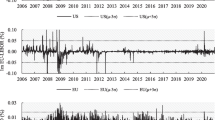Abstract
Previous work on the exposure of equity markets to exchange rate risk, surprisingly, found stock returns were not significantly affected by exchange rate fluctuations. In this paper, we examine the relation between China, Japan and USA MSCI (Morgan & Stanley Capital International) daily equity index returns and SAFE (State Administration of Foreign Exchange) exchange rate returns of Chinese RMB and Japanese Yen in US dollar. We find a significant relation between Asian foreign equity stock returns and Chinese RMB and Japanese Yen exchange rate returns. This article incorporates foreign exchange values as partial determinants of Asian foreign equity market returns and suggests that currency risk is of hedging concern to investors with implications for portfolio management. We implement our result in portfolio’s CaR determination under VaR constraints.
Similar content being viewed by others
References
Aguiar, M., “Devaluation, foreign currency exposure and investment: the case of mexico”, University of Chicago, Mimeo, 2001.
Allayannis, G., “Exchange rate exposure revisited”, Working Paper, Darden graduate School of Business, Uni. of Virginia, 1996.
Amihud, Y., Evidence on Exchange Rates and the Valuation of Equity Shares, in Exchange Rates and Corporate Performance, Y. Amihud and R. Levich, eds. Bur Ridge, IL: Irvin Publishing, 1994.
Bodnar, G. and W. Gentry, “Exchange rate exposure and industry characteristics: evidence from Canada, Japan and the U.S.”, Journal of International Money and Finance, Vol. 12, No. 1, pp29–45, 1993.
Coles, S. G., An Introduction to Statistical Modeling of Extreme Values, Springer, 2001.
Danielsson, J. and C.G. de Vries, “Value-at-Risk and extreme returns”, Integrated Risk Management, ed. P. Embrechts, 2000.
de Haan, L. and S. I. Resnick, “Limit theory for multivariate sample extremes”, Z. Wahrschein Lichkeits Theorie Verw. Gebiete, Vol. 40, pp317–337, 1977
Deheuvels, P., “Point processes and multivariate extreme values”, Jour. of Multi. Anal., Vol. 13, pp257–272, 1983.
Embrechts, P., F. Lindskog, and A. McNeil, “Modeling dependence with copulas and applications to risk management”, Handbook of Heavy Tailed Distributions in Finance, ed. S. Rachev, Elsevier, Chap.8, pp329–384, 2001.
Forbes, K., “How do large depreciations affect firm performance”, NBER, Working Paper No. 9095, 2002.
Giddy, I.H., “Devaluations, revaluations and stock market prices”, Ph.D. dissertation, University of Michigan, 1974.
Giogio, S., Risk Measures for the 21st Century, ISBN: 0-470-86154-1, 2004.
He, J., and L. K. Ng, “The foreign exchange exposure of japanese multinational corporations”, Journal of Finance, Vol. 53, pp733–753, 1998.
Hartmann, P., S. Straetmans, C.G. de Vries, “Market linkages in crisis periods”, http://www.tinbergen.nl/discussionpapers/01071.pdf, 2001.
Jorion, P., “The exchange rate exposure of U.S. multinationals”, Journal of Business, Vol. 63, pp331–345, 1990.
Longin, F. and B. Solnik, “Extreme correlation of international equity markets”, Journal of Finance, Vol. 56, pp649–676, 2001.
Reiss, R.-D. and M. Thomas, Statistical Analysis of Extreme Values in Insurance, Finance, Hydrology and Other Fields, second ed., Birkhauser Verlag, Basel. Boston. Berlin, 2001.
Sibuya, M., “Bivariate extreme statistics”, I. Ann. Inst. Statist. Math, Vol. 11, pp195–210, 1960
Smith, R.L., “Statistics of extremes, with applications in the environment, insurance and finance”, Extreme Value in Finance, Telecommunications and the Environment, B. Finkenstadt and H. Rootzen, ed. Chapman and Hall/CRC, 2003.
Zhang, Z., PhD Dissertation, Department of Statistics, University of North Carolina, 2002.
Zhang, Z. and R. L. Smith, “Behavior of multivariate maxima of moving maxima” http://www.unc.edu/depts/statistics/postscript/rs/BehaviorM4_R.pdf, 2003.
Zhang, Z. and R. L. Smith, “On the estimation and application of max-stable processes”, http://www.unc.edu/depts/statistics/postscript/rs/OEMSP.pdf. 2004.
Basale Accord www.yats.com/doc/jorion-frm-31-en.pdf
Author information
Authors and Affiliations
Additional information
Djibrilla Moussa, Lecture University of Bamako, Mali; Master degree in engineering in Applied Mathematics from Tianjin science (1999); Ph.D. in Financial management science from Tianjin university (2005), interested in Risk management by extreme value theory.
Wei Zhang, Ph.D. in Systems Engineering: Professor of Finance at both Tianjin University and Tianjin University of Finance and Economics; Associate Editor at Journal of Management Sciences in China, Management Review. Research interests: Financial Engineering and Risk Management, Entrepreneurial Finance.
Rights and permissions
About this article
Cite this article
Moussa, D., Zhang, W. Modeling jumps in returns of financial assets as M4 processes: Measured exchange rate exposure of Asian equity portfolio. J. Syst. Sci. Syst. Eng. 14, 364–380 (2005). https://doi.org/10.1007/s11518-006-0199-2
Issue Date:
DOI: https://doi.org/10.1007/s11518-006-0199-2




